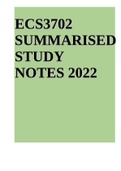ECS3702
SUMMARISED
STUDY
NOTES 2022
, Created by Achievers Tutorial Centre (Pretoria Campus) - 078 628 2401
CHAPTER ONE
WORLD TRADE AND THE NATIONAL ECONOMY
International Economics
It is concerned with the exchange of goods, services, factors of production and capital
across national boundaries.
International Trade
The reasons for and the benefits/gains from international trade are no different from
those associated with domestic transactions - as with domestic transactions,
international transactions offer the benefits of specialisation, allowing us to gain
increased output from a given amount of inputs. Voluntary trade is therefore held to
be mutually beneficial, increasing the economic welfare of all parties involved in such.
It is the conduct of trade, rather than the benefits that flow from it, that distinguish
international transactions from domestic transactions. Differences in the way in which
international trade is conducted arise as a result of influences such as:
Exchange rates: transactions within a country are financed by that country's own
currency. International transactions, on the other hand, require, for example, that
importers convert their own currency into the currency of the country from which
they are purchasing the imported goods. Such conversion takes place via
exchange rates, which are subject to change, and therefore introduce an element
of risk into such transactions that does not occur with domestic transactions;
Commercial policies: a national government may impose a variety of restrictions
upon international transactions that cannot be imposed upon domestic
transactions. Examples may include tariffs, import quotas, export subsidies and
exchange controls;
Different domestic policies: national governments have differing views as to the
aims of fiscal/monetary policy. This can result in varying levels of inflation between
trading partners, affecting their competitive positions;
Statistical data: the detailed tracking of all transactions between a country and
its trading partners means that statistics regarding international transactions tend
to be of a greater depth than those relating to domestic transactions;
Relative immobility of factors of production: It is far easier for production
factors to move around within the borders of a country than to move between
countries;
, Created by Achievers Tutorial Centre (Pretoria Campus) - 078 628 2401
Marketing considerations: Companies cannot always apply the same marketing
techniques that have proven to be successful in one country to other international
markets. Different countries often have different demand patterns and market
requirements. These necessitate the formulation of sales techniques appropriate
to such.
, Created by Achievers Tutorial Centre (Pretoria Campus) - 078 628 2401
International Transactions - An Empirical Glimpse
Some Interesting Statistics:
Between 1958 and 2004, the value of world exports increased from $108 billion to
$8.8 trillion, as measured at constant dollars ;
In 2004, the US generated nearly 10% of the value of world exports, and
consumed nearly 17% of the value of world imports;
In 2004, Germany also generated 10% of the value of world exports, and
consumed nearly 8% of the value of world imports;
In 2004, China replaced Japan as the world's third largest exporter;
In 2003, more than a quarter of world trade was conducted between Western
European countries;
The US is the leading exporter and importer of commercial services (shipping,
banking, communications, etc);
Direct foreign investment (e.g. the setting up by domestic companies of
manufacturing plants in foreign countries) is growing rapidly.
As a result of the above, a global marketplace for the production and distribution of
goods is emerging. This process is referred to as globalisation.
Globalisation has led to a situation where international trade and direct foreign
investment are expanding faster than global output. Over the last 45 years or so, the
volume of world exports has increased by an annual average compound rate of 6.2%,
while world output increased by 3.8% per annum over the same period.
Indicators of International Trade
Much of the growth in trade has been not only in commodities, but also in services
(tourism, shipping, banking communications etc), the latter accounting for a fifth of
world exports in 2003.
A further indicator of growing globalisation, as mentioned above, is the increasing
extent of direct foreign investment, the US being the main recipient of such, with the
EU being one of the largest sources of DFI.
Table 1.1A (P. 4, P.T.) indicates global merchandise trade. A glance quickly reveals
the dominant position of Germany as the world's leading exporter of merchandise, and
that of the US as the dominant importer of merchandise.
Due to its commercial links with member countries of the Commonwealth, the UK is
second only to the US in the exporting of services, and behind only the US and
Germany in the importing of such (see Table 1.1C, P.5 P.T.)
Table 1.1B (P. 5, P.T.) also indicates the growing importance of Asia as a contributor
to world trade, especially the increasing influence of China as it moves from a
command to a market-oriented economy.




